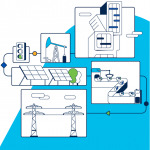As part of Cisco Live Las Vegas 2023 we organized a Utilities Leadership Summit for top leaders in the industry. Our goal was to gain deeper insight into our customers’ challenges, discuss innovations, and build strategic relationships. We explored high-level questions such as:
- What are the top challenges and opportunities on the minds of utilities leaders in the US?
- Which technologies have them hitting the accelerator?
- And what do they value when building strategies and architectures for modernizing the grid?
We anchored the summit on three key topics: substation automation, distribution automation and utility wide-area networks. During Cisco Live US, clients, partners, and Cisco colleagues discussed these topics.
Since then, I’ve been reflecting on both formal discussions and casual conversations at Cisco Live US and considering the implications for other utilities. I’ve distilled my thinking into five takeaways.
Takeaway #1: Utilities want fewer devices with more functionality
When we surveyed utilities leaders about their top challenges, they were clear that resources are constrained. Given the lack of time and money, they value hardware that can perform multiple functions.
The Cisco Catalyst IR8340 Rugged Series Router is a great example. In a single piece of hardware, it offers a switch and router plus security (Cisco Cyber Vision sensor, Zone-based firewall and IDS/IPS capability) and a timing module for substation synchronization. It helps utilities save on power and heat while helping optimize rack space in the substation. The summit reaffirmed why the IR8340 has been very well received as a key platform for substation automation.
In the quest for efficiency and value, utilities leaders also told us they want end-to-end solutions proven to work. We’re able to provide that assurance to utilities with Cisco Validated Designs – for example, our designs for Substation Automation and SD-WAN for Distribution Automation are specifically developed for utilities.
Takeaway #2: Utilities are moving rapidly on SD-WAN
Summit attendees shared that they’re acting quickly to adopt SD-WAN for substation automation. There seemed to be consensus that SD-WAN will be a good fit for distribution automation, too. From my perspective, SD-WAN has gained significant momentum over the past six months. I attribute that to greater collaboration between IT and operational technology (OT) teams. While OT still owns final decisions, IT is showing OT the power of enterprise networking tools. These enterprise tools are very familiar to IT leaders, who can show OT leaders the potential ease of use, security, and automation they bring.
Takeaway #3: Virtualization in the substation is coming faster than you might think
It was mildly surprising to hear about rapidly increasing adoption of SD-WAN; it was almost shocking to discover how quickly some utilities are moving ahead on virtualization in the substation. There appears to be general acceptance that traditional applications will eventually be virtualized. After all, virtualization makes it possible to automate and centralize all the devices and systems within a substation. It enables greater security, visibility, and operational efficiency. It also unleashes new levels of intelligence. Although utilities are still early in this journey, they seem committed to making it happen.
Takeaway #4: First surprise: Utilities see the benefits of efficiently accessing and securing non-critical assets with the cloud.
Cisco’s Secure Equipment Access service enables an organization’s staff and contractors to access connected devices in a highly controlled and efficient manner. Because Secure Equipment Access is cloud based, I assumed utilities would be unable to use it to support certain substation assets. Conversations during Cisco Live US revealed that I was wrong. Utilities leaders I spoke with see great potential in using Secure Equipment Access to support ancillary non-critical equipment – for example door access control and fire detection systems – inside their substations. Streamlining the processes needed to keep these systems updated, secure and running smoothly is a powerful advantage.
Takeaway #5: Industry-specific partnerships matter
Cisco maintains strategic relationships with several industry-relevant partners, including Schweitzer Engineering Laboratories (SEL). Utilities customers at the summit were vocal about the value of such Cisco partnerships.
As utilities continue investigating cellular connectivity for substations and distribution network assets, there is growing interest in private LTE and 5G. Cisco solutions already support both, and we continue to invest in testing and proof-of-concepts. In fact, we shared our ongoing collaboration with Verizon to bring a joint solution for connecting substations and distribution assets—news that was well received during the event.
Ultimately, the summit demonstrated that utilities are no longer technology laggards; (surprise no. 2) some of the most innovative are emerging as technology leaders. To learn more about how Cisco is collaborating with utilities, listen to the replay of my session from Cisco Live US, The New Digital Substation.
Learn more
- Cisco Catalyst IR8340 Rugged Series Router
- Cisco Catalyst IE9300 Rugged Series Switches
- Cisco Cyber Vision
- Cisco Catalyst SD-WAN
- Cisco Secure Equipment Access

CONNECT WITH US